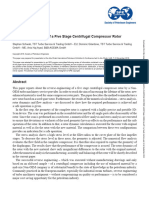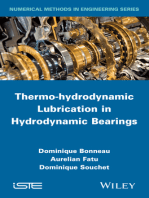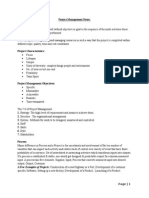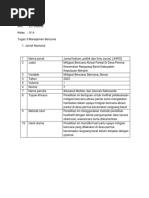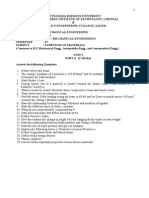Project Report
Project Report
Uploaded by
Muhammad SulemanCopyright:
Available Formats
Project Report
Project Report
Uploaded by
Muhammad SulemanOriginal Title
Copyright
Available Formats
Share this document
Did you find this document useful?
Is this content inappropriate?
Copyright:
Available Formats
Project Report
Project Report
Uploaded by
Muhammad SulemanCopyright:
Available Formats
COMPUTER PROGRAMMING
Instructor: Engr. Asim Rehmat
PROJECT REPORT
Wet Gas Reservoir Calculator
Group Members
Hafiz Muhammad Suleman
2014-PET-03
Hafiz Hamza Saleem
2014-PET-17
Hafiz Shoaib Maqbool
2014-PET-24
Wet Gas Reservoir Properties Calculator
PROJECT REPORT
Table of Contents
1
Introduction..............................................................................................................................2
Problem Statement...................................................................................................................3
Objective..................................................................................................................................3
Working...................................................................................................................................3
4.1
Functions...........................................................................................................................3
4.1.1
Specific gravity..........................................................................................................3
4.1.2
Compressibility Factor...............................................................................................7
4.1.3
Formation Volume Factor..........................................................................................8
4.1.4
Viscosity....................................................................................................................8
4.1.5
Pseudo Reduced Temperature (Tpr) and Pseudo Reduced Pressure (Ppr)...................9
Importance...............................................................................................................................9
Program Features...................................................................................................................10
Conclusion.............................................................................................................................10
Wet Gas Reservoir Properties Calculator
PROJECT REPORT
Project Report
1 Introduction
Reservoir is place inside the earth where hydrocarbons are stored. These hydrocarbons have
different composition which affects their phase i.e. they can be liquid or gases. Gases having
higher composition of intermediate components of hydrocarbons are wet gases. A reservoir can
have wet gases, dry gases or black oil depending on the composition of hydrocarbons.
Wet gases when produced on surface, certain amount of liquid is produced from them, due to
change in pressures. The key to analysis of the properties of wet gas is that the properties of the
surface gas are not the same as the properties of the reservoir gas. Liquid condenses from the
reservoir gas as it moves from reservoir conditions to the surface conditions. Thus the
composition of the surface gas is quite different from the composition of the reservoir gas.
At the surface there are two or three stage separation systems. Two stage separator includes
one separator and one stock tank while three stage separator system includes two separators and
one stock tank. Well stream is separated into stock tank liquid (condensate) separator gas or stock
tank gas. Properties of these surface gases and liquids are easily calculated by production data.
Properties of all three of these fluids must be included in the recombination calculation to
calculate reservoir wet gas properties.
Wet Gas Reservoir Properties Calculator
PROJECT REPORT
Figure 1.1- Two stage and Three stage Seperation System
2 Problem Statement
During initial production of wet gas from well, several properties of wet gases are required.
These properties of reservoir fluids helps to take critical decisions in order to take maximum
production. Several formulas and complex graphs are required with extensive calculation to
calculate these properties. A computer program can be used to calculate and evaluate all the
reservoir properties using formulas and equations of graph. This program can save valuable time
of petroleum engineer and provide error free results to petroleum engineer for taking critical
decisions.
3 Objective
To calculate the properties of wet gases i.e. specific gravity, formation volume factor, viscosity of
reservoir gas, compressibility factor, and pseudo reduced temperature and pseudo reduced
pressure.
4 Working
Computer program uses formulas and equations of graphs to calculate specific gravity,
compressibility factor, formation volume factor, viscosity, pseudo reduced temperature, and
pseudo reduced pressure. Each of these property have its own function which are described
below:
Wet Gas Reservoir Properties Calculator
PROJECT REPORT
4.1 Functions
Wet gas reservoir Calculator has different functions in its C++ source code which are explained
below in detail.
4.1.1 Specific gravity
It is the ratio of density of the wet gas to the density of ideal gas (air) at same conditions of
temperature and pressure. As the composition of wet gas changes on the surface its specific
gravity cannot be found directly. There are two methods to calculate specific gravity:
1. When separatror,stock tank gas and stock tank liquid properties are known
This cases can further have either two stage separation or three stage separation.
Two stage separation
In two stage separation we know the following properties of fluids
Gas oil ratio of separator
Gas oil ratio of stock tank
Specific gravity of separator
Specific gravity of stock tank
API of stock tank liquid
GOR
Number of standard cubic ft of gas dissolved per bbl of stock tank oil.
API Gravity
Wet Gas Reservoir Properties Calculator
PROJECT REPORT
The American institute gravity or API gravity is a measure of how heavy or light a petroleum
liquid is compared to water.
These properties are inputs for the function which gives specific gravity of reservoir gas.
Following formulas are used in two stage separation.
Function in Source Code which calculates specific gravity using two stage separator is:
float TwoStageSeparator(float Rsp1, float Rst, float SGsp1, float SGstg, float API, float *VEQ)
Three stage separation
In three stage separation there are two separators and one stock tank and in this case following
properties are known
GOR of primary separator
GOR of secondary separator
GOR of stock tank
Specific Gravity of primary Separator
Specific Gravity of Secondary Separator
Specific Gravity of Stock tank.
API Gravity of Stock tank.
Following Formulas are used to calculate the specific gravity using three stage separator.
Wet Gas Reservoir Properties Calculator
PROJECT REPORT
Function in Source Code which calculates specific gravity using three stage separator is:
float ThreeStageSeparator(float Rsp1, float Rsp2, float Rst, float SGsp1, float SGsp2, float
SGstg, float API, float *VEQ)
2. When stock tank gas properties are not known
Very often the specific gravity of the stock tank gas are not measured. Sometimes in three stage
separation system, the quantity of secondary separator gas is unknown. A Formula is available
for this situation.
VEQ:
The equivalent volume is the volume of separator gas and stock tank gas in standard cubic
feet/stock tank bbl. plus the volume in scf that would be occupied by the bbl. of stock tank liquid
if it were a gas.
For Two stage
Where;
Wet Gas Reservoir Properties Calculator
PROJECT REPORT
For Three stage
Where;
AGP
The additional gas produced AGP is related to the mass of gas produced from second separator
and the stock tank.
For two Stage Separation System
Where;
For Three Stage Separation System
Where;
For Two Stage Separator Function in Source Code is:
float TwoStageSeparator1(float Rsp1, float SGsp1, float Psp1, float Tsp1, float API, float *VEQ)
For Three Stage Separator, Function in Source Code is:
Wet Gas Reservoir Properties Calculator
PROJECT REPORT
float ThreeStageSeparator1(float Rsp1, float SGsp1, float Psp1, float Tsp1, float Tsp2, float API,
float *VEQ)
4.1.2 Compressibility Factor
The compressibility factor is the ratio of volume occupied by gas to the volume occupied by
same gas when it is behaving ideally.
Z=
Vactual
Videal
Compressibility factor is measured using Tr, Pr and Specific Gravity res.g . Specific gravity of wet
gas is output of first function.
Function for Calculating Z Factor in Programm is:
float zfactor(float Tpr, float Ppr)
4.1.3 Formation Volume Factor
Volume of reservoir gas required to produce one standard cubic feet of gas at surface. Following
inputs are used to calculate the Formation Volume Factor.
Gas oil ratio of primary separator
Compressibility Factor
Reservoir Temperature
Reservoir Pressure
VEQ
Equation Used to Calculate FVF is;
Wet Gas Reservoir Properties Calculator
PROJECT REPORT
Function in Program for FVF is:
float FVF(float Rsp1, float z, float VEQ, float Tr, float Pr)
4.1.4 Viscosity
It is defined as resistant to flow of fluids.
Following Parameters are used to calculate the viscosity of reservoir gas.
Specific Gravity of reservoir Gas
Reservoir Temperature (Tr)
Reservoir Pressure (Pr)
Compressibility Factor (z)
Formula Used to calculate viscosity of wet gas is
Where;
Function used in program for calculating viscosity of wet gases is:
float viscosity(float Tr, float Pr, float SGrg, float z)
4.1.5 Pseudo Reduced Temperature (Tpr) and Pseudo Reduced Pressure (Ppr)
Reduced temperature and reduced pressure are defined as;
Where;
Tpr=
T
Tpc
Ppr=
P
Ppc
Wet Gas Reservoir Properties Calculator
PROJECT REPORT
Functions used for Tpr and Ppr is:
float RTpr (float Tr, float SGrg)
and
float RPpr (float Pr, float SGrg)
5 Importance
In Case of wet gas reservoir, the gas from the reservoir is converted to gas as well as
liquid when it comes to the surface. So the specific gravity of surface gas is different
from the reservoir gas. For this reason we have to calculate the specific gravity of wet gas
in order to determine its other properties.
Tpr and Ppr values are used to calculate the compressibility factor of wet gas using Law of
Corresponding states.
The Z-factor of the gas tells us about the deviation of the gas from the ideal behavior. It is
used to calculate viscosity and formation volume factor of the wet gas.
Formation Volume Factor tells us about the number of reservoir barrels required to
produce one stock tank barrel of oil. In this way it tells us about the production of oil and
hence the economic potential of reservoir.
Viscosity is an important property of fluid. In Petroleum industry, if viscosity of gas is
high the production and flow rate will be less. So we must know the viscosity of the gas
in order to determine the recovery from the reservoir.
Viscosity of wet gas helps to determine the secondary and tertiary recovery techniques
needed to be applied during production from well.
6 Program Features
In manual calculations of these properties we have to use certain graphs but in this program
we do not need any graphs so our task becomes easier.
We get more precise results using this program as the errors in the reading of graphs (in
manual calculations) are omitted.
Wet Gas Reservoir Properties Calculator can determine all the properties at the same time or
you can calculate properties of your choice individually.
Wet Gas Reservoir Properties Calculator
PROJECT REPORT
7 Conclusion
WGRP Calculator is very important petroleum industry. This calculator is helpful in determining
the properties of wet gas easily and more efficiently using C++ language. It involves the use of
coding from source library and displays accurate results on the screen. Hence the WGRP
Calculator is easy, efficient and quick manner of knowing the properties of wet gas.
You might also like
- Correction Bac LLCE Jour2Document4 pagesCorrection Bac LLCE Jour2letudianttv100% (1)
- Styrene Pressure Drop Tutorial ASPEN PDFDocument10 pagesStyrene Pressure Drop Tutorial ASPEN PDFTomNo ratings yet
- Fire Relief Rate Calculation-Part 2Document4 pagesFire Relief Rate Calculation-Part 2zubair195100% (1)
- API 12j SizingDocument8 pagesAPI 12j SizingsegunoyesNo ratings yet
- Res Eng Ch14 Parts 1-12Document37 pagesRes Eng Ch14 Parts 1-12AiwarikiaarNo ratings yet
- PVT Laboratory Procedures and ReportDocument9 pagesPVT Laboratory Procedures and ReportOdinaka Ody MadukaNo ratings yet
- Gas Reservoir Engineering Application ToolkitDocument20 pagesGas Reservoir Engineering Application Toolkitnishant41288100% (2)
- PVT Data Useful For Design of Oil Production FacilitiesDocument4 pagesPVT Data Useful For Design of Oil Production FacilitiesBesan LaduNo ratings yet
- PVT Data Useful For Design of Oil Production Facilities - Oil & Gas JournalDocument6 pagesPVT Data Useful For Design of Oil Production Facilities - Oil & Gas Journalvasudha50% (2)
- Flash Calculation: "Definition of Oil Relative Volume in Diff. Lib." On Page 149Document2 pagesFlash Calculation: "Definition of Oil Relative Volume in Diff. Lib." On Page 149leonelz6aNo ratings yet
- GB 02 Mixing Process DesignDocument28 pagesGB 02 Mixing Process DesignRamakrishna Somu100% (3)
- Hydrostatic Tank Gauging System: Reference ManualDocument34 pagesHydrostatic Tank Gauging System: Reference ManualionpanaNo ratings yet
- LAB11103Document46 pagesLAB11103hamdy nabawyNo ratings yet
- Petroleum SoftwareDocument5 pagesPetroleum SoftwareAbdullah AlhuqebiNo ratings yet
- 2014 EPTANKsv3 UserManual PDFDocument50 pages2014 EPTANKsv3 UserManual PDFAnonymous msVFzaNo ratings yet
- HP - Designing For Pressure Releases During Firespart 2Document8 pagesHP - Designing For Pressure Releases During Firespart 2Jungmuk LeeNo ratings yet
- Reverse Engineering of A Five Stage Centrifugal Compressor RotorDocument13 pagesReverse Engineering of A Five Stage Centrifugal Compressor RotorMahmoud AbdellatifNo ratings yet
- Richard Nakka's Experimental Rocketry Web Site: Solid Rocket Motor Theory - GUIPEPDocument8 pagesRichard Nakka's Experimental Rocketry Web Site: Solid Rocket Motor Theory - GUIPEPSharat ChandraNo ratings yet
- Manual PL InterpretationDocument15 pagesManual PL InterpretationDayanand Singh90% (10)
- MatlabDocument47 pagesMatlabalkadyasNo ratings yet
- NMR 06 Hydrocarbon Analysis HCDocument18 pagesNMR 06 Hydrocarbon Analysis HCHafidz DezulfakarNo ratings yet
- Sondex-Manual-PL-Interpretation PDFDocument15 pagesSondex-Manual-PL-Interpretation PDFLuis100% (1)
- ESP System Selection and Performance Calculations - PetroWikiDocument13 pagesESP System Selection and Performance Calculations - PetroWikimoheeNo ratings yet
- Simulation and Planning of Pipeline Emptying OperationsDocument9 pagesSimulation and Planning of Pipeline Emptying OperationsMarcelo Varejão CasarinNo ratings yet
- SimulatorDocument220 pagesSimulatorLarbi HammounNo ratings yet
- Mass Balance Exercise: Individual Exercise On Block Flow Diagrams, Flowsheets and Mass BalancesDocument11 pagesMass Balance Exercise: Individual Exercise On Block Flow Diagrams, Flowsheets and Mass BalancesAnonymous ka2kX4jNNo ratings yet
- LAB11106Document60 pagesLAB11106hamdy nabawyNo ratings yet
- Richard Nakka's Experimental Rocketry SiteDocument9 pagesRichard Nakka's Experimental Rocketry SiteMikeVVNo ratings yet
- 6.1.2 Detail DesignDocument11 pages6.1.2 Detail DesignfaisalnadimNo ratings yet
- Well Performance Case Study - Oil Well Design: Task 1. Develop A Calibrated Blackoil ModelDocument10 pagesWell Performance Case Study - Oil Well Design: Task 1. Develop A Calibrated Blackoil ModelAnonymous wOKNzWNo ratings yet
- Ce408 Design Project StatementDocument5 pagesCe408 Design Project StatementAkshat KejriwalNo ratings yet
- Determine Compressor Settling-Out Conditions For Recycle Gas Loop DesignDocument6 pagesDetermine Compressor Settling-Out Conditions For Recycle Gas Loop DesignMoutushi Bhowmik100% (1)
- Retrofit Tool: Calculation of Performance Change of System ComponentsDocument5 pagesRetrofit Tool: Calculation of Performance Change of System ComponentsNPUIUNo ratings yet
- West Demonstration Program: W E S TDocument9 pagesWest Demonstration Program: W E S TCristian Fernando Muñoz LabradorNo ratings yet
- ME 410L - Jet Engine Experiment (JET) - Instructor: Reza Baghaei LakehDocument9 pagesME 410L - Jet Engine Experiment (JET) - Instructor: Reza Baghaei LakehTonya WhitneyNo ratings yet
- DF3 - PVT DataDocument10 pagesDF3 - PVT Dataadnan0307No ratings yet
- PVT ExpressDocument5 pagesPVT ExpressHadi HendizadehNo ratings yet
- Water InjectionDocument11 pagesWater InjectionWaqas SaleemNo ratings yet
- GPA08 PaperDocument9 pagesGPA08 PaperhicherkNo ratings yet
- Site Visit ReportDocument7 pagesSite Visit ReportAhmad0% (1)
- The Science of Storage Tanks Emissions CalculationsDocument26 pagesThe Science of Storage Tanks Emissions CalculationsDavid García BarradasNo ratings yet
- 01b Hydrocarbon Phase BehaviourDocument43 pages01b Hydrocarbon Phase BehaviourMohammad Elhedaby100% (1)
- ESP 9-Step DesignDocument31 pagesESP 9-Step Designeng.osama100% (3)
- Hydro PVT Manual Chap 3Document89 pagesHydro PVT Manual Chap 3Sameh ZaguiaNo ratings yet
- Compressor Performance CharacteristicsDocument72 pagesCompressor Performance Characteristicsnasirfahim100% (3)
- Jonas Biteus - Mean Value Engine Model of A Heavy Duty Diesel EngineDocument34 pagesJonas Biteus - Mean Value Engine Model of A Heavy Duty Diesel EngineMuhidin ArifinNo ratings yet
- Ger 4207Document16 pagesGer 4207XXX100% (1)
- SPE-173598-MS A Simplified Approach To Sizing 2 and 3 Phase Separators PDFDocument21 pagesSPE-173598-MS A Simplified Approach To Sizing 2 and 3 Phase Separators PDFRicardo VargasNo ratings yet
- Core Laboratories: Reservoir Fluid Study For Occidental de Colombia Caricare-5 Well, Form.: M2Document51 pagesCore Laboratories: Reservoir Fluid Study For Occidental de Colombia Caricare-5 Well, Form.: M2Anne SophiaNo ratings yet
- Simulation and CalibrationDocument16 pagesSimulation and CalibrationHassanNo ratings yet
- Petroleum Engineering: Principles, Calculations, and WorkflowsFrom EverandPetroleum Engineering: Principles, Calculations, and WorkflowsRating: 5 out of 5 stars5/5 (1)
- Roll-to-Roll Manufacturing: Process Elements and Recent AdvancesFrom EverandRoll-to-Roll Manufacturing: Process Elements and Recent AdvancesJehuda GreenerNo ratings yet
- Natural Gas Processing from Midstream to DownstreamFrom EverandNatural Gas Processing from Midstream to DownstreamNimir O. ElbashirNo ratings yet
- Troubleshooting Process Plant Control: A Practical Guide to Avoiding and Correcting MistakesFrom EverandTroubleshooting Process Plant Control: A Practical Guide to Avoiding and Correcting MistakesRating: 1 out of 5 stars1/5 (2)
- Process System Value and Exergoeconomic Performance of Captive Power PlantsFrom EverandProcess System Value and Exergoeconomic Performance of Captive Power PlantsNo ratings yet
- Case Studies in Mechanical Engineering: Decision Making, Thermodynamics, Fluid Mechanics and Heat TransferFrom EverandCase Studies in Mechanical Engineering: Decision Making, Thermodynamics, Fluid Mechanics and Heat TransferRating: 5 out of 5 stars5/5 (2)
- Queerness - Experience - Politics. - Veronica Zebadua Yanez Hampshire Fall 2016 SyllabusDocument12 pagesQueerness - Experience - Politics. - Veronica Zebadua Yanez Hampshire Fall 2016 SyllabusLjubisa MaticNo ratings yet
- Uasa Year 1Document9 pagesUasa Year 1NorhaslizaNo ratings yet
- Glosario Juridico y Tecnico CientificoDocument93 pagesGlosario Juridico y Tecnico CientificoDiego Gabriel GrassoNo ratings yet
- El Dorado County CPS (Gomez) CACI Report Grievance ProcedureDocument6 pagesEl Dorado County CPS (Gomez) CACI Report Grievance ProcedureRick ThomaNo ratings yet
- HRM Project On Pakistan Tobacco Company (PTC)Document26 pagesHRM Project On Pakistan Tobacco Company (PTC)Mehak Malik100% (2)
- 09 WCDMA RNO Access Failure Problem AnalysisDocument50 pages09 WCDMA RNO Access Failure Problem AnalysisshahidusmaniNo ratings yet
- Charmed - 1x08 - The Truth Is Out There and It Hurts - enDocument49 pagesCharmed - 1x08 - The Truth Is Out There and It Hurts - enGa ConNo ratings yet
- Class XI - Physics Workbook PDFDocument212 pagesClass XI - Physics Workbook PDFArshad Basha100% (1)
- Jelly Roll Morton PDFDocument1 pageJelly Roll Morton PDFecoboy93No ratings yet
- Artifact2 Field Observation and ReflectionDocument6 pagesArtifact2 Field Observation and Reflectionapi-549623622No ratings yet
- Download The Bible in Shakespeare 1st Edition Hannibal Hamlin ebook All Chapters PDFDocument71 pagesDownload The Bible in Shakespeare 1st Edition Hannibal Hamlin ebook All Chapters PDFredehkkitani100% (6)
- Data Book 2009 Michelin OtrDocument102 pagesData Book 2009 Michelin OtrMiguel A Parra Baeza50% (2)
- Refrat Bedah Plastik Sepsis in BurnsDocument16 pagesRefrat Bedah Plastik Sepsis in BurnsAnindya Nur Qurani100% (1)
- CE 218 SYL-Lecture - Spring 2014Document3 pagesCE 218 SYL-Lecture - Spring 2014Amber DavisNo ratings yet
- 06 - CONVERSION - Oracle Outbound Interface Process With ExampleDocument8 pages06 - CONVERSION - Oracle Outbound Interface Process With Examplejaish20% (1)
- Home CastingDocument15 pagesHome CastingchrisNo ratings yet
- The Daily Times Journal: Three Country Folks, Made Their Way To Explore The Beauty of NatureDocument1 pageThe Daily Times Journal: Three Country Folks, Made Their Way To Explore The Beauty of NatureAlexandra Mae SolNo ratings yet
- Project Management NotesDocument19 pagesProject Management NotesSatyendr Suhas KulkarniNo ratings yet
- Quantitative Problem Chapter 3: Solution: PVDocument5 pagesQuantitative Problem Chapter 3: Solution: PVAni SubelianiNo ratings yet
- Bamboo Research in The PhilippinesDocument12 pagesBamboo Research in The PhilippinesEA Kev RamosNo ratings yet
- Preparing For Court Testimony Based On The MMPI-2 Guide 4th Edition 8/14/12Document45 pagesPreparing For Court Testimony Based On The MMPI-2 Guide 4th Edition 8/14/12mohamadgh10100% (1)
- Cradles of Early ScienceDocument24 pagesCradles of Early ScienceMichelle MalabananNo ratings yet
- UntitledDocument82 pagesUntitledRamlah RNo ratings yet
- Applied Electronics II (Chapter 4)Document34 pagesApplied Electronics II (Chapter 4)Ermias MesfinNo ratings yet
- 1 - Direct and Indirect SpeechDocument1 page1 - Direct and Indirect SpeechAhmad RazaNo ratings yet
- Strength of Materials QB 2015Document10 pagesStrength of Materials QB 2015smg26thmayNo ratings yet
- Santa Rosa City Biology 2 Week 2Document4 pagesSanta Rosa City Biology 2 Week 2Bernard D. Fajardo Jr.No ratings yet
- Criminal Law GPR 105-Lecture 9 19th Jan 2012Document13 pagesCriminal Law GPR 105-Lecture 9 19th Jan 2012Joseph McDonald100% (1)
- 13-Final Report & Legal Writing-3610Document38 pages13-Final Report & Legal Writing-3610kokmunwai717No ratings yet

















